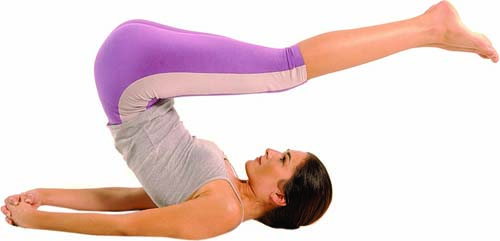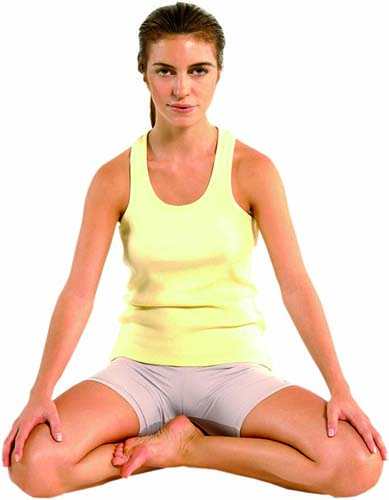Restoring your harmony
Yoga's stretching and relaxation techniques can be particularly beneficial for varicose veins. Certain positions, such as the Plow and the Candle, promote circulation and the drainage of blood from the legs because the legs are raised above the head.

+ Except when we lie down to sleep, most of us live straight up, meaning that we are constantly with our heads as the highest point of the body. Yoga is a therapy that aims to attain the unity of mind, body and spirit, through the teaching of body postures, breathing, relaxation, concentration and meditation. Hatha yoga, the most popular branch of the form, uses many inverted asanas. Inverted asanas reverse the action of gravity on the body, instead of everything being pulled toward the feet, the orientation shifts toward the head. These exercises encourage a rich supply of blood flow to the brain, nourishing the neurons and flushing out toxins. In these positions, the blood flows toward the heart, helping to prevent varicose veins and relieving discomforts caused by this ailment.
ROCKING CHAIR
This pose is used as a series of movements to be practiced at the beginning of a yoga session to warm up the body. Practicing this pose is recommended for improved blood circulation to your legs. As the name suggests, this asana rocks the body, while at the same time it releases tensions making it a good exercise before going to bed.
1. Sit on the floor (or on a padded mat), with your legs bent, leaving the soles of your feet on the floor. Place your hands behind your knees, with your thumbs pointed outward. Keep your chin pressed to your chest to prevent back injuries. Slowly rock backward. Next use your hands to push your legs backward and inhale as your back touches the mat. Remember to keep your chin pressed to your chest. Exhale and return to the first position. Do this rocking motion between 10 to 15 times.

2. Lift up your feet, supporting them with your arms and begin to rock back your body. Rock back and forth five or six times, keeping the legs bent to get the body ready. Inhale and take advantage of the rocking motion to stretch out your legs behind your head. If you can, try to touch the floor with the tips of your toes. Exhale and rock forward, without lifting up your chin. Repeat this movement another 10 or 15 times. Next, lie back down for a minute or two to relax your body.

THE CANDLE
This pose encourages the flow of blood to the heart, helping to improve blood circulation and to prevent varicose veins.
1. Lying down, inhale and extend your arms next to your body, then lift your legs until they form a 90 degree angle. Exhale and when you inhale again, lift up your hips and back and bring your legs over your head.

2. Bend your arms, supporting your back with your hands, and bring your feet to the floor behind your head. Raise your left leg, stretched (your chin needs to be pressed against your chest, so that your neck doesn't tense up).

3. Bring your right leg up, with your toes pointed to the ceiling and stay in this position as long as you can. Next, slowly lower your torso, as you bend your legs, placing each segment of your backbone against the floor as you come down.

THE RIGHT ANGLE
Encourages correct blood circulation and helps to decongest the legs. There are several variants to this pose, for different level yoga practitioners.
Lying down with your arms stretched out beside your body, lift up your legs to form a 90 degree angle. Stay in this position for two or three minutes and as you become more familiar with the pose, you can increase the time.

Variant 1
If you have trouble keeping your legs up in the air, support them against the wall from your buttocks to your ankles.
Variant 2
Another alternative to this pose is to bend your legs over the seat of a chair to give your legs support; the chair should be at the height of your knees.
If you suffer from high blood pressure it's a good idea to put a pillow or small cushion under your head when you do this posture or asana.
PRACTICING BREATHING
The deep-breathing exercises in yoga may further alleviate discomfort by getting more oxygen into the bloodstream. Lie down on your back and place your ankles on the seat of a chair. Breathe slowly and uniformly from your diaphragm and through your nose.
Warning. Don't practice this breathing technique if you have high blood pressure or heart problems, or before consulting your doctor.

THE PLOW
This position favors blood circulation.
1. Begin the position lying on your back, with your legs together, arms by your sides next to your body and palms of your hands pressed to the floor. Bring your chin toward your chest and press your back muscles to the floor. Inhale through your nose and raise your legs up until they are at 90 degree angle with your torso. Exhale, then inhale and bring your hips off the floor, supporting your back with your hands.

2. Without bending your knees, stretch out your legs by bringing them behind your head, until your toes touch the floor. Your arms should stay forward, with the palms of your hands pressed to the floor. Stay in this position breathing slowly and deeply. Next, inhale through your nose and slowly lower your legs while you exhale. Concentrate on how each segment of your backbone presses against the floor as you come down.

FLEXIBILITY AND HARMONY
Yoga is a discipline designed to improve your flexibility and inner harmony. The exercises use gentle movements without straining your body. When practicing the asanas remember not to strain yourself. There is no need to push yourself too far. Remember to use gentle movements and don't push your body into a pose. With time and willpower, you will improve your flexibility and health naturally and become more in tune with your body. It is important to remember to use your body with gentleness, patience and consistency, to prevent side effects like sore muscles or tiredness.
SIDDHASANA
This position favors blood circulation.
Sit on the floor, with your legs in the form of a V and your hands placed on your knees. Bend your right leg, placing the ball of your foot against your left inner thigh. Next, bend your left leg and place the heel near your pubic bone.

THE LOTUS POSE
Sit on the floor with your legs spread out in the form of a V. Clasp hold of your right foot with both hands and bring it high onto the left thigh, up to the groin, if you can. Keep the ball of your right foot pointed upward and your right knee placed on the floor. Next, bring the left foot over the right and place it in the groin. Cup your hands, with the tips of your middle finger and thumb touching. In this mudra or hand gesture, the hands have a strong symbolic importance. The union between the fingers symbolizes your connection with universal knowledge and your search for union between your own consciousness and the Universe. The Lotus yoga pose is a perfect meditation posture. You can also place your index finger and thumb together as a sign of your search for harmony and balance.


Comment about this article, ask questions, or add new information about this topic: